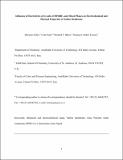Files in this item
Influence of electrolytes of Li salts, EMIMBF4 and mixed phases on electrochemical and physical properties of Nafion membrane
Item metadata
| dc.contributor.author | Safari, Maryam | |
| dc.contributor.author | Naji, Leila | |
| dc.contributor.author | Baker, Richard T. | |
| dc.contributor.author | Afshar Taromi, Faramarz | |
| dc.date.accessioned | 2018-05-22T23:33:01Z | |
| dc.date.available | 2018-05-22T23:33:01Z | |
| dc.date.issued | 2017-09-15 | |
| dc.identifier | 250163630 | |
| dc.identifier | 65ba8c85-29aa-483c-b132-d445f826c412 | |
| dc.identifier | 85019546994 | |
| dc.identifier | 000403346000009 | |
| dc.identifier.citation | Safari , M , Naji , L , Baker , R T & Afshar Taromi , F 2017 , ' Influence of electrolytes of Li salts, EMIMBF 4 and mixed phases on electrochemical and physical properties of Nafion membrane ' , Journal of Applied Polymer Science , vol. 134 , no. 35 , 45239 . https://doi.org/10.1002/app.45239 | en |
| dc.identifier.issn | 1097-4628 | |
| dc.identifier.other | Bibtex: urn:d417e9c5865a3609e3e7306253596703 | |
| dc.identifier.other | ORCID: /0000-0002-3304-3280/work/59464812 | |
| dc.identifier.uri | https://hdl.handle.net/10023/13480 | |
| dc.description.abstract | Electrolyte-soaked Nafion is commonly used as an ionic polymer in soft actuators. Here, a multi-technique investigation was applied to correlate the electrochemical behavior of Nafion membranes with their microstructures and nanostructures as a function of electrolyte type. The influence of electrolytes of Li salts with different counteranions on the Nafion membranes was investigated in terms of hydration level, structure (using X-ray diffraction and small angle X-ray scattering), stress–strain characteristics, and electrochemical behavior (by cyclic voltammetery and electrochemical impedance spectroscopy). The effects of using ionic liquid (IL), as the electrolyte, addition of different supporting solvent and the addition of Li+ ions to water-free IL-soaked membranes on the structural and electrochemical properties of Nafion were examined. The nano- and microstructure of the Nafion changed considerably as a function of the identity of the electrolyte solution. The electrochemical behavior of the IL-soaked samples was compared with that of the water-soaked Li+-exchanged Nafion. It was seen that the ionic conductivity of the Nafion membranes was reduced significantly when water was replaced by pure IL. Using the supporting solvents increased the conductivity of IL-soaked Nafion membranes dramatically. The presence of a small amount of Li+ ions together with the IL ions caused a significant decrease in charge transfer resistance and increases in double layer capacitance and in ionic conductivity over that of the water-free sample and also over water-soaked Li+-exchanged Nafion. These findings can be useful to improve the knowledge on Nafion's microstructure and also to improve the electromechanical behavior of Nafion-based ionic polymer–metal composites actuators. | |
| dc.format.extent | 1811214 | |
| dc.language.iso | eng | |
| dc.relation.ispartof | Journal of Applied Polymer Science | en |
| dc.subject | Electrochemical studies | en |
| dc.subject | EMIMBF4 | en |
| dc.subject | Li salts | en |
| dc.subject | Nafion membrane | en |
| dc.subject | QD Chemistry | en |
| dc.subject | NDAS | en |
| dc.subject.lcc | QD | en |
| dc.title | Influence of electrolytes of Li salts, EMIMBF4 and mixed phases on electrochemical and physical properties of Nafion membrane | en |
| dc.type | Journal article | en |
| dc.contributor.institution | University of St Andrews. School of Chemistry | en |
| dc.contributor.institution | University of St Andrews. St Andrews Sustainability Institute | en |
| dc.contributor.institution | University of St Andrews. EaSTCHEM | en |
| dc.identifier.doi | 10.1002/app.45239 | |
| dc.description.status | Peer reviewed | en |
| dc.date.embargoedUntil | 2018-05-22 |
This item appears in the following Collection(s)
Items in the St Andrews Research Repository are protected by copyright, with all rights reserved, unless otherwise indicated.

